Take this bread: A STORYLINE OF COMMUNION (+ a bonus lesson on how baby cannibalism is frowned upon)2/20/2019 Written by Pastor/Leader/Organizer Sara Gross Samuelson Who would of thought that so much could come from the simple act of breaking bread? But there’s a lot tied up in the practice of communion (also called Eucharist, the Lord’s Supper). Take a few moments and think about any questions or hang-ups you might have around the Christian practice of communion. Maybe they’re from personal experience. Maybe they’re observed vicariously through the experience (or trauma) of others. If it helps… write them down. Take a moment as well to think about your own motion towards or away from the table. What has been, or do you hope is, holy about this space? Part of our journey at Storyline is to hold space for all those experiences as valid and important parts of our story. Last Sunday, we gathered to de-construct some of hang-ups about communion and to begin to re-construct a community ethos around our practice of breaking bread. Sara’s amateur doodling talents served as a timeline for the story of how communion came to be. We’ll attempt to walk through that story here.  First, we head back to the meal practices of ancient Israel. At meals in the ancient near-east, the common menu was what you see on this table. Seasonal vegetables sometimes showed up, legumes or grain, wine, oil for seasoning and always… always there was bread. Jews would have spoken words of blessing over their meal as they ate together. The most common blessing is called the HaMotzi, which is Hebrew for “who brings forth”. The words began something like “Blessed are you Adonai, maker of Heaven and Earth, for you bring forth grain from the earth….” Always the blessing would acknowledge the origin story of whatever was on the table. God’s earth sent forth nourishment for God’s people. (An ancient Farm to Table ethos!) Jesus would have known intimately the mealtime practice of the HaMotzi, having grown up with Joseph speaking those words of blessing over every meal as the bread was broken. 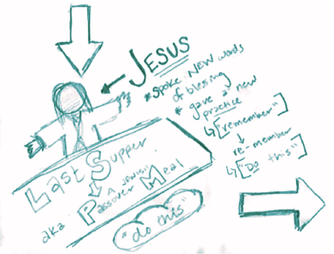 During Jesus life, he began using the practice of eating to help reverse some of the unhelpful practices that he saw had cropped up around who could eat, and who could eat with whom. (Spoiler alert!) That’s why on the night where Jesus was betrayed, when we read about the story of the Last Supper (Matthew 26, Mark 14, Luke 22) Jesus made sure to bless the bread. Because there was always bread… it was part of the Jews daily habits. And on that particular night, it was Passover, so the meal would have been extra special. Except, instead of speaking the special Passover blessings, Jesus spoke NEW words of blessing over the bread and the wine. And in them, he gifted a NEW regular practice to the people of God: DO THIS to remember me. Remember me. You can think of remembering as recalling a memory of something that happened. But you can also think of remembering as RE-MEMBERING. Putting something together again. Which is what Jesus was asking his followers to do. Gather and DO the things that Jesus had been doing. 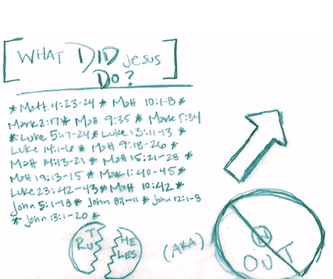 So let’s take a moment and remind ourselves of the stories of what Jesus DID during his life on this earth. Above are just a few references (sorry you might have to squint…. But please note that this is only a small chunk of examples of Jesus actions and take that into consideration when I tell you his actions were pretty consistent). They’re stories of healing, of pointing out the children and the women and calling attention to their stories. Of touching and being touched by sick people. (A big no-no in Ancient NearEastern culture). Of dining with tax collectors and fishermen and common laborers. (Not the coolest kids in the middle school cafeteria for sure.) Basically… Jesus broke a lot of rules. But the rules Jesus broke were strategic ones. They were rules whose existence made life unlivable for people like widows and lepers. They were rules that created inequality and injustice. They set up a definite “in” crowd and made sure that it was clear how to get IN. Except mostly, the motion was that people got PUSHED OUT. Those were the rules that Jesus broke. And that was the life that Jesus lived. These are the people to keep in mind when we hear Jesus say “DO THIS” to RE-member me. So when the Jews began to gather after Jesus’ death to remember Jesus…. That’s mostly what they did. They RE-membered him by telling all those stories about the healing and the reaching and the teaching and the rule-breaking. And they gathered at tables with all kinds…. Widows, laborers, Levites, shop owners, children, tax collectors etc. etc. And they broke bread. And they spoke words of blessing over it. And they blessed each other in the breaking and the passing. And the community felt power in their collective stories. And they took and gave care. 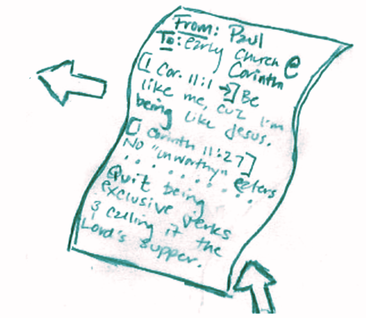 But slowly, some of the community of new and early Christians began getting tired of being known as the kooks in the neighborhood. They grew weary of the work of being different and they got tired of explaining to their friends that they weren’t actually eating bodies. (True story: Early Christians got a bad rap as baby cannibals because A) they were always talking about body and blood and B) children and babies showed up at gatherings from which they were normally excluded). So, in an effort to repair their reputation, some folks in Corinth began inviting only certain important people to their church meetings, because they wanted to appear legit and look good to the empire. The gatherings began to look more and more like the IN-Crowd Jesus had previously been trying to break up. While others on the outside went hungry, the wealthiest most privileged people were having an exclusive party where they gorged on food and drink, and called it church. So Paul, one of the leaders of all these early church movements, wrote them a letter reminding them of the story of Jesus, and telling them to knock it off. When we read 1 Corinthians 11:27, (“ Whoever, therefore, eats the bread or drinks the cup of the Lord in an unworthy manner will be answerable for the body and blood of the Lord.”), we’re hearing Paul calling out these so-called Christians for being exclusive jerks. The “unworthy” behavior was their acts of exclusion. He’s reminding them that they are invoking the name and symbol of Jesus body and blood, and to be truly deserving of it means to remember Jesus’ movement; the movement that breaks apart the in-crowd and moves ever-outwards to the margins. 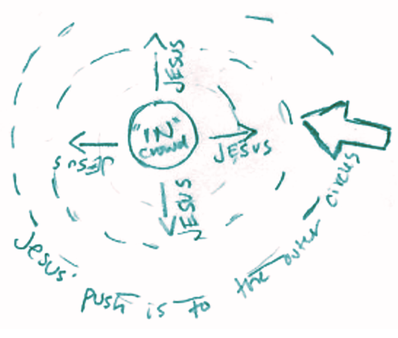 Indeed, Jesus life calls us to move out and create ever-widening circles around the bread that we break. So… to that end, as a community, We’re hoping to hold those stories to account. We’re asking ourselves what the next circle out from us is and how we can move ourselves out into that circle. For now… maybe it is inviting our children to the table. Then, who are our neighbors in Milwaukie and Oak Grove? Whom are we called to re-member? Who are we called to bring together and seek wholeness with? Written by Sara Gross Samuelson, Pastor/Leader/Organizer-Storyline Community In your household this week, consider what ever-widening circles are being drawn in to your table. As a physical practice to pair with that consideration, use the bread recipe below (or another one that meets your needs as a family) and bake as you talk.
Remember, the people of God in Ancient Israel didn’t just speak the HaMotzi (prayer of thanks for the bread from the earth to their table) they lived it. Speaking the words drew awareness, awareness drew practice, and practice turned them towards God. Let the baking and the rising and the breaking and the sharing be a practice for your family that turns you towards the next widest circle in your neighborhood. Ingredients 5-6 cups all-purpose flour (you can substitute whole wheat flour for 1 or 2 cups). 2 tablespoons of dry yeast 2 tablespoons brown sugar 1 tablespoon salt 2 cups hot water (120-130 degrees F) A cake pan/pyrex pie dish of hot water Directions Mix 3 cups of the flour with the yeast, sugar and salt. Pour in the hot water and beat 100 strokes (or 3 minutes with a mixer). Stir in the remaining flour until the dough loses its stickiness. Turn onto a floured surface. Knead for 8 minutes. Place dough in a greased bowl and cover with a warm damp cloth. Let rise for 15 minutes in a warm spot (away from drafts). Punch down and divide the dough into two pieces. Shape into round loaves and place on a greased baking sheet. Cut an "X" one-half inch deep in each of the loaves with a wet sharp knife. Place baking sheet with loaves in the middle of a COLD oven. Place a pan of hot water on the lowest shelf. Heat the oven to 400 degrees and bake 40-50 minutes until golden brown. Written by Anna Hoesly, Community Organizer/Pastor/Leader-Storyline Community 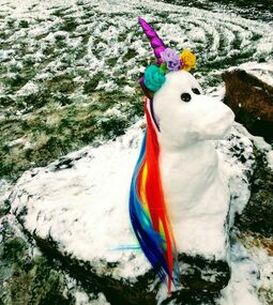 Our co-created masterpiece: Emily, majestic "Unicorn-of-the-snow". Our co-created masterpiece: Emily, majestic "Unicorn-of-the-snow". There is something powerful about being connected to those in our community. A snow day is a prime opportunity to kindle the simple sweetness of knowing our neighbors. Confession... I could only actually think of 7 ways to do so. But thankfully some members of our facebook page came through heroically with some brilliant additions! Offer up your own idea in the comments below! 1) Play outside... and say hello! This is the best time to meet other playful spirits in your neighborhood. Make an intention to introduce yourself to the neighbor throwing snowballs across the street! 2) Invite a neighbor in for soup or hot cocoa. 3) Make Snow Ice cream to share! 4) Build a collective masterpiece. Build a giant snow man and ask a neighbor to contribute to the work of art. Maybe they have a great hat or a carrot that looks exactly like Olaf's nose! 5) Check in on an elderly neighbor. This is the exact time when elderly or otherwise vulnerable neighbors need a community around them! Check in on them to make sure they are doing okay and have what they need! 6) Shovel or salt a neighbor's steps! 7) Check in on a local warming shelter. These cold cold days can be an incredibly dangerous time for our houseless neighbors, and an incredibly busy time for warming shelters. You might check in to see if they are running low on any practical needs like blankets, or helping hands. Or just drop of some coffee or treats to say a thanks to the hard-working volunteers! The two nearest are Clackamas Service Center and Annie Ross House. And now for some audience additions... Can you think of another? Add them in the comments below! 8) Play pictionary using snow sculptures as your medium! 9) Share your sleds with neighbors at the park. 10) Invite neighbors to join you around the fire pit! Because snow + fire = magic. Everyone knows that. |
AuthorWe have rotating blog posts by leaders and members of our community! Archives
February 2021
Categories |
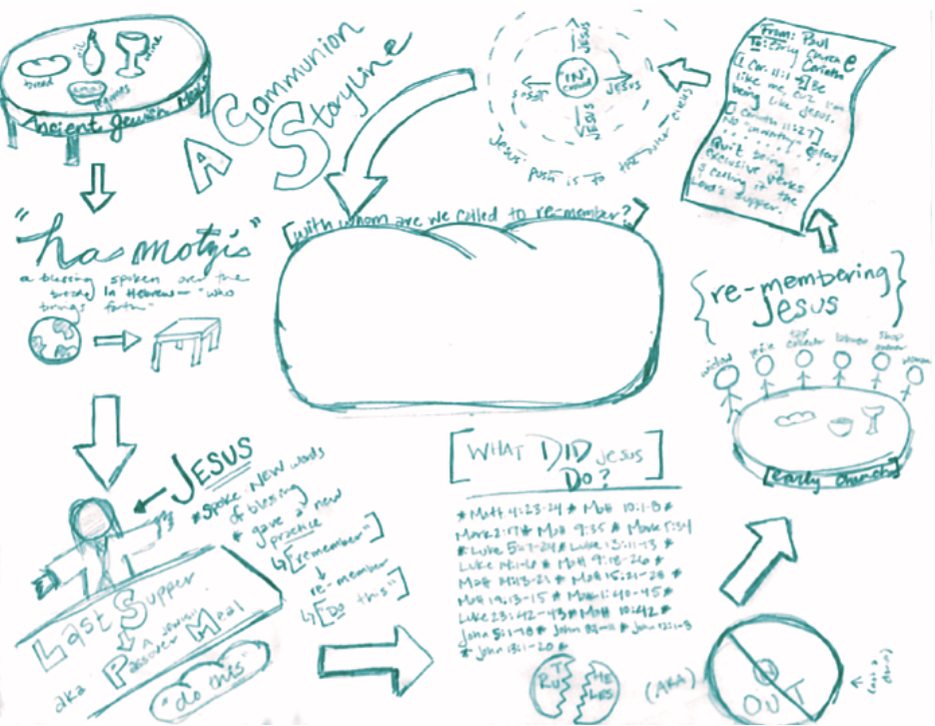
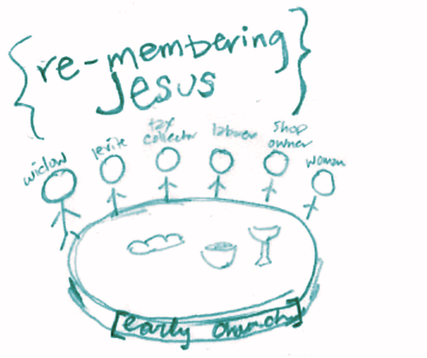
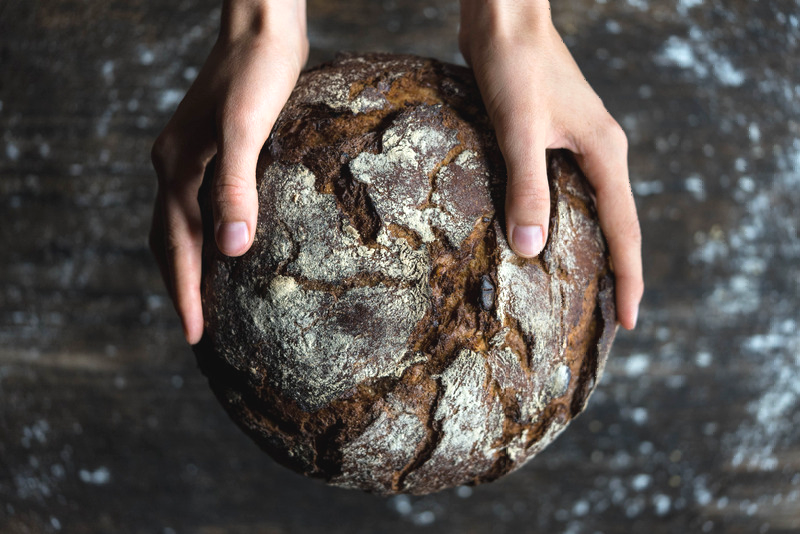
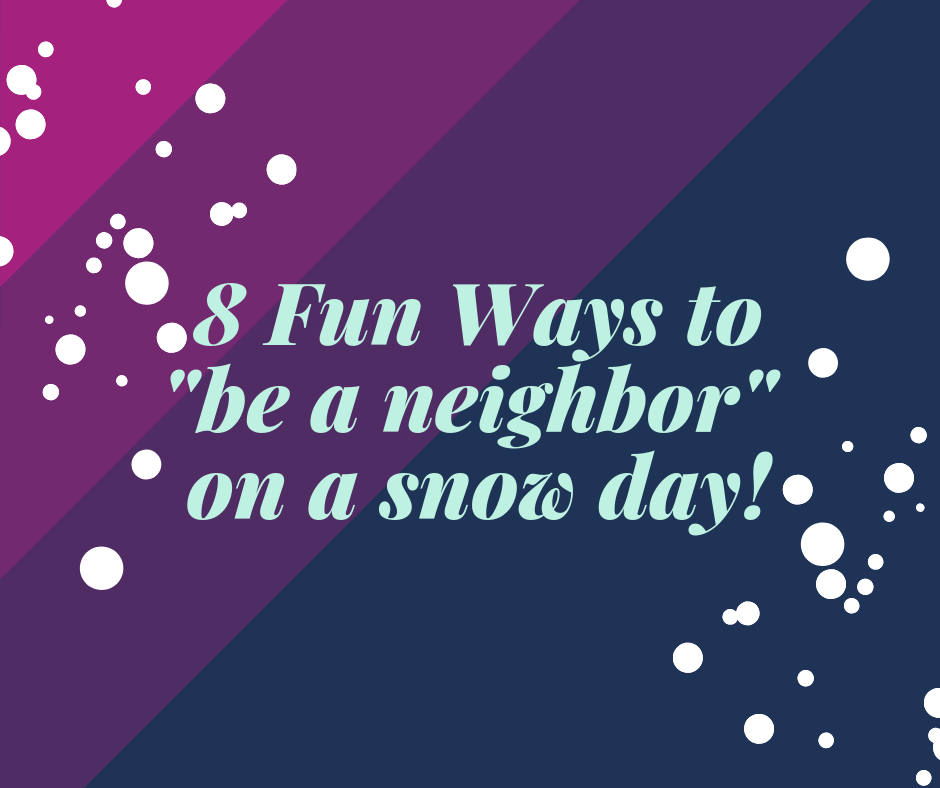
 RSS Feed
RSS Feed